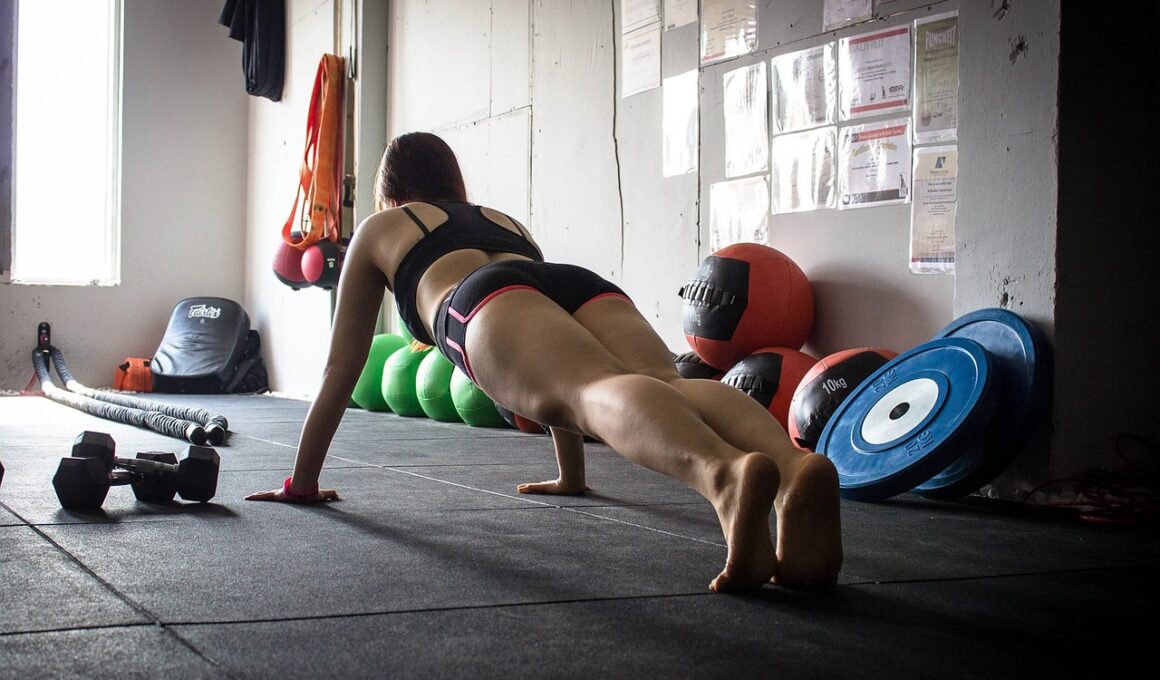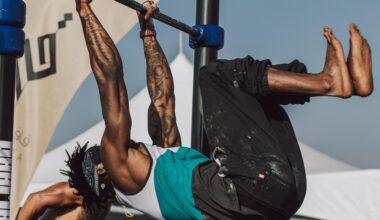Step-by-Step: Mastering the Plank as an Isometric Bodyweight Exercise
The plank is a fundamental isometric bodyweight exercise that builds stability and strength through various muscle groups. It specifically targets the core, arms, and shoulders, establishing a solid foundation for many other physical activities. Practicing this exercise can improve your posture, enhance athletic performance, and contribute to better balance. The beauty of the plank lies in its simplicity; you don’t require any equipment, making it a fantastic option for workouts at home or anywhere you prefer. For those new to exercise or experiencing injury, it is advisable to progress gradually and consult a physician before starting any routine. Understanding proper form and technique is crucial for maximizing benefits while avoiding injuries. Beginners should start with shorter holds and gradually increase their time as endurance builds. More advanced practitioners can challenge themselves by adding variations to the traditional plank, targeting different muscles and intensifying the workout. With dedication and practice, mastering the plank can lead to significant strength gains and overall improvement in fitness levels. Embracing this exercise can set the stage for a sustainable path toward a healthier lifestyle.
Setting Up for Success
To perform a proper plank, begin by finding a flat, comfortable surface that allows you to maintain your balance and focus. Place your forearms on the ground, ensuring they are parallel and directly beneath your shoulders. Your body should form a straight line from your shoulders to your ankles, avoiding any sagging or arching of the back. Engage your core muscles by actively pulling your belly button towards your spine, which stabilizes your torso. This engagement is essential for maintaining proper form throughout the exercise. Your feet should be hip-width apart, allowing for better stability and support. You can either keep your toes pointed or contact the ground with the tops of your feet, based on your comfort level. While in position, ensure your head is in a neutral position, with your gaze slightly forward, which keeps your spine aligned correctly. The key to long-duration holds is to focus on breath control, allowing each inhale and exhale to provide a steady rhythm to your hold. Gradually build up to holding the plank for longer periods, starting with 20-30 seconds.
As you become comfortable with the standard plank, consider integrating variations into your workouts to keep them interesting and challenging. Some well-known modifications include the side plank, Romanian plank, and plank with shoulder taps. These variations not only target different muscle groups but also enhance overall functional strength and stability. For example, the side plank focuses on the obliques, providing a great way to enhance lateral stability. To perform the side plank, lie on your side and raise your body on one forearm, stacking your feet. Keep your body in a straight line, holding the position for a set amount of time. The Romanian plank adds a dynamic element by incorporating movement. From the standard plank position, lift one leg at a time, alternating while maintaining your balance and stabilization. The plank with shoulder taps challenges core stability by requiring you to lift one hand at a time to tap the opposite shoulder while keeping the hips steady. These variations not only offer physical benefits but also promote mental engagement, preventing workout monotony.
Incorporating the Plank into Your Routine
To maximize the benefits of the plank, it’s essential to incorporate it effectively into your workout routine. One approach is to include it in a circuit training setup, alternating between strength exercises and planks. You can start with a typical circuit that might include push-ups, lunges, and bodyweight squats before transitioning to the plank. Aim to hold each exercise for a specific time, with the plank serving as both a strength component and a brief recovery period for your muscles. Furthermore, experts recommend performing planks at least three to four times per week. Monitoring your progress is crucial—keep a workout journal to note the duration of your plank holds, variations attempted, and overall improvements in strength and endurance. As you advance, you might want to set specific goals, like holding a plank for an entire minute without breaking form. Alternatively, challenge yourself by experimenting with time intervals, gradually increasing your goals as you develop mastery. Consistency remains vital, as making the plank a regular fixture in your routine can lead to impressive strength improvements over time.
Focusing on mental aspects during your plank practice is essential for achieving success. Maintaining concentration while holding the position can introduce mindfulness into your workout, helping you become more aware of your body mechanics and breathing. Set short, achievable goals for each plank session to reinforce this focus. For example, aim to hold for an extra five seconds every week. Establishing a playlist of motivating songs can also enhance your workout experience, making it enjoyable and ideal for multiple repetitions. While in a plank, visualize your strength and stability—the more you embrace the processes, the more likely you are to reach your desired outcomes. Additionally, practicing visualization techniques, such as imagining forming a touchdown posture, can help sharpen your concentration as you hold the plank. Embrace the entire workout experience, from achieving the goal to enjoying the journey. Rest and recovery play crucial roles in ensuring your muscle development and overall health. Keep in mind that incorporating stretching after your plank sessions can support flexibility and muscle recovery. Finally, celebrate progress, and don’t hesitate to share your experiences!
Common Mistakes to Avoid
Although the plank seems straightforward, many individuals fall into common traps that can lead to ineffective workouts and potential injuries. One major mistake is allowing the hips to sag or pike upwards during the hold. This misalignment strains your back and disengages core muscles. Therefore, it is imperative to always maintain a straight body alignment from head to heels. Additionally, avoid holding your breath; focus on breathing steadily through your belly and ribs to maintain core engagement. Another common pitfall is failing to engage the transverse abdominis, essential for stabilizing your core during the plank. By actively pulling your tummy button towards your spine, you’ll assist in maintaining better form. Lastly, setting unrealistic duration goals can lead to improper technique. Instead, emphasize building your hold time progressively. If you’re unable to maintain proper form for the intended duration, lower your time goal. Asking a workout partner or utilizing a mirror can help maintain proper alignment. While building strength through the plank, listen to your body and adjust your holds as needed.
As you continue to learn and practice the plank, tracking your progress can significantly boost motivation and help you set realistic expectations. There are various techniques, including utilizing fitness apps or worksheets to monitor your plank benefits, including duration, variations attempted, and personal fitness levels. Some fitness applications offer progress graphs, enabling you to visualize your improvements over time, which encourages consistency in your workouts. Additionally, consider joining online fitness communities or forums about isometric exercises, which can foster motivation and challenge you to push your limits further. By joining a supportive community, you will find inspiration and tips for variations and progressions suited to your level of fitness. Engaging with fellow fitness enthusiasts increases accountability, allowing you to remain committed to your goals and healthy lifestyle. Moreover, connecting with individuals who share similar interests can enhance your overall workout experience. Ultimate success comes from a balance of determination, setting goals, and celebrating milestones achieved. Embrace the plank journey, focusing on mastery and gradual improvement as you strengthen your entire body.
In conclusion, the plank is an effective isometric bodyweight exercise that builds core strength and stability while being accessible to all fitness levels. By understanding and practicing proper form and technique, you can significantly reduce the risk of injury. Whether you’re a beginner or advanced practitioner, integrating variations and challenges into the plank routine will foster a more exciting and engaging experience. Consistency is key, and monitoring your progress will allow for motivation and realization of your fitness goals. Remember, mental focus during each plank session plays a crucial role in achieving desired outcomes. As you commit to mastering this foundational exercise, recognize the benefits it can impart on your overall physical capabilities. Embrace the challenges and celebrate all achievements, regardless of size, as they contribute to your fitness journey. Incorporate planks into your routine at least three times per week, and consider exploring new variations. Finally, remember to listen to your body and focus on improvements, knowing that strength development takes time. With dedication and passion, the plank can become a powerhouse exercise that transforms your body and enhances your everyday activities.


